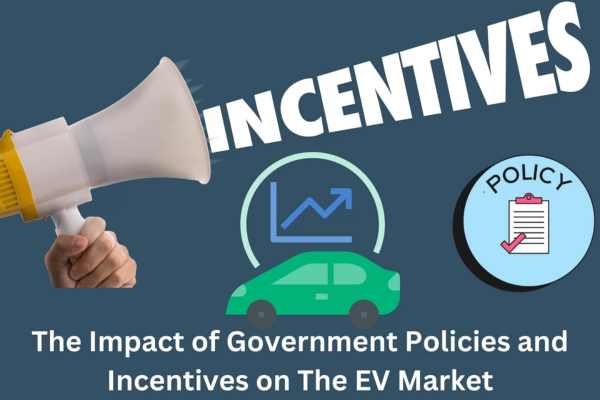
Table Of Content:
- Introduction
- Government Incentives to Promote EVs
- Government Policies to Promote EVs
- Conclusion
- Frequently Asked Questions
Introduction:
As the world grapples with the urgent need to address climate change and reduce dependence on fossil fuels, electric vehicles (EVs) have emerged as a promising solution for sustainable transportation. Recognizing the pivotal role of EVs in mitigating emissions and promoting energy independence, governments worldwide are implementing a range of incentives and policies to spur their adoption. In this article, we explore the multifaceted landscape of government initiatives aimed at accelerating the transition to electric mobility, from financial incentives to regulatory measures and infrastructure investments.
By incentivizing the expansion of charging infrastructure, governments address one of the key barriers to EV adoption is range anxiety. When consumers have convenient access to charging stations, they are more likely to consider electric vehicles as a viable transportation option, further driving uptake and market growth.
Moreover, some governments offer incentives for businesses and property owners to install charging infrastructure at their facilities, such as tax credits or rebates for purchasing and installing charging equipment. By incentivizing the deployment of charging infrastructure in residential, commercial, and public spaces, governments create a more accessible and convenient charging experience for electric vehicle owners, thereby accelerating adoption and market growth.
Government Incentives to Promote EVs

1. Financial Incentives:
- Tax credits.
- Rebates
- Grants
• Tax credits.
• Rebates
• Grants
2. Equity and Accessibility:
3. Battery Recycling and Sustainability:
4. Grid Integration and Energy Resilience:
5. International Collaboration and Standardization:
6. Inclusive Transportation Planning:
- urban planning initiatives,
- transit-oriented development projects,
- transportation infrastructure investments
7. Public-Private Partnerships:
8. Long-Term Planning and Policy Stability:
- Emissions reduction targets,
- Vehicle electrification mandates, and
- Incentive programs with predictable funding streams.
Government Policies to Promote EVs

1. Regulatory Measures:
2. Infrastructure Investments:
3. Public Awareness and Education:
Conclusion:
Government incentives and policies are crucial drivers of electric vehicle adoption, providing the necessary support and incentives to overcome barriers and accelerate market growth. From financial incentives to regulatory measures, infrastructure investments, and public awareness campaigns, governments employ a range of strategies to promote electric mobility and combat climate change. As we navigate the transition to a more sustainable transportation future, collaboration between governments, industry stakeholders, and consumers will be essential to realizing the full potential of electric vehicles and building a cleaner, greener world for future generations.
Government incentives and policies continue to evolve in response to the dynamic landscape of electric vehicle adoption and technological advancements. As we look towards the future, several key areas warrant attention to further accelerate the transition to electric mobility.
Frequently Asked Questions:
Governments around the world are offering a range of incentives to promote EV adoption in 2024. These incentives include financial incentives such as tax credits, rebates, and grants for purchasing EVs, as well as incentives for installing charging infrastructure at home or in public spaces. Additionally, some regions offer perks like access to HOV lanes, reduced registration fees, and exemption from vehicle emissions testing.
Government policies play a crucial role in shaping the EV market by setting ambitious targets for EV sales, implementing emission regulations favoring zero-emission vehicles, and investing in charging infrastructure. By providing clear guidance and support, governments create a conducive environment for automakers, consumers, and other stakeholders to transition towards electric mobility.
In 2024, governments may introduce new incentives or adjust existing policies to accelerate EV adoption and address emerging challenges. These changes could include expanding financial incentives, updating regulations to promote EV-friendly infrastructure development, or launching targeted campaigns to raise awareness about the benefits of EV ownership. Staying informed about these updates is essential for consumers and businesses interested in adopting EVs.
Government incentives and policies have proven to be effective in stimulating EV adoption by making electric vehicles more affordable, convenient, and accessible to consumers. Financial incentives help offset the higher upfront costs of EVs, while supportive policies, such as ZEV mandates and emissions regulations, drive automakers to invest in EV production and innovation. Additionally, investments in charging infrastructure address range anxiety and improve the overall EV ownership experience.
To take advantage of government incentives and policies promoting EV adoption in 2024, individuals and businesses can start by researching available incentives in their region and understanding eligibility criteria. They can then explore different EV models, compare financial incentives, and consider factors such as charging infrastructure availability and range to make informed purchasing decisions. Additionally, staying engaged with local policymakers and advocating for supportive EV policies can help drive further progress towards sustainable transportation goals.

